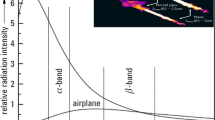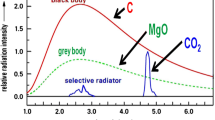Abstract
Infrared-guided missiles caused 90% aircraft damage. Infrared decoy flares are effective counter measure against infrared missiles. Decoy flare thermal signature depends mainly on black body emission of carbonaceous combustion products. Thermite particles can offer substantial heat output to promote black body emission. Reduced graphene oxide (RGO) is a promising material for advanced infrared decoy flares. RGO could act as ideal black-body emitter with superior thermal properties and high interfacial surface area. This study is dedicated to investigate novel synergism between Fe2O3 and RGO; Fe2O3 NPs of 3.56 nm were fabricated using hydrothermal synthesis technique. RGO nano-sheets of 10 µm dimensions and 10 nm thickness were developed via the reduction of graphene oxide, developed by Hummer̓ method. Complete reduction of GO to RGO was confirmed by Raman spectroscopy. Amorphous nano-sheets structure was observed using TEM; XRD diffractogram demonstrated tiny characteristic broad peak for amorphous RGO. Decoy flare formulation based on Fe2O3, RGO, reactive metal fuel (Mg), and fluorocarbon polymer (teflon) were developed. Thermal signature was evaluated using Arc-Optics IR spectrometer (1–6 µm). Multi-component MTV nanocomposite flare based on 6 wt % RGO and 2 wt % Fe2O3 demonstrated superior spectral and radiometric performance. It offered an increase in average intensity by 130% to reference MTV formulation; additionally it offered superior relative intensity Ɵ value of 0.76. While RGO could act as novel black body emitter; thermite reaction between Fe2O3 NPs and surplus magnesium fuel could provide substantial heat output; that could promote RGO black body emission.








Similar content being viewed by others
References
E.-C. Koch, Pyrotechnic countermeasures: II. Advanced aerial infrared countermeasures. Propellants Explos. Pyrotech. 31(1), 3–19 (2006)
E.-C. Koch, Metal-Fluorocarbon Based Energetic Materials (Wiley, New York, 2012)
E.C. Koch, Pyrotechnic countermeasures. Propellants Explos. Pyrotech. 31(1), 3–19 (2006)
K. Pal, Transparent Conducting Films (2019).
C.W. Wong et al., Response surface methodology optimization of mono-dispersed MgO nanoparticles fabricated by ultrasonic-assisted sol–gel method for outstanding antimicrobial and antibiofilm activities. J. Clust. Sci. 31(2), 367–389 (2020)
V. Singh et al., Graphene based materials. Prog. Mater. Sci. 56(8), 1178–1271 (2011)
K. Pal, Hybrid Nanocomposites: Fundamentals, Synthesis, and Applications (CRC Press, Boca Rtaon, 2019)
E.C. Koch, 2006–2008 Annual review on aerial infrared decoy flares. Propellants Explos. Pyrotech. 34(1), 6–12 (2009)
E. Koch, Metal-fluorocarbon pyrolants. J. Pyrotech. 27, 38 (2008)
J.A. Conkling, C. Mocella, Chemistry of Pyrotechnics: Basic Principles and Theory (CRC Press, Boca Raton, 2010)
M. Comet, D. Spitzer, From thermites to metastable interstitial composites (MIC). Actualite Chim, pp. 20–25 (2006)
M. Comet et al., Phosphorus-based nanothermites. J. Phys. Chem. Solids 71(2), 64–68 (2010)
A.S. Mukasyan, A.S. Rogachev, S.T. Aruna, Combustion synthesis in nanostructured reactive systems. Adv. Powder Technol. 26(3), 954–976 (2015)
M. Talawar et al., Emerging trends in advanced high energy materials. Combust. Explos. Shock Waves 43(1), 62–72 (2007)
E.C. Koch, Metal–fluorocarbon pyrolants: X. influence of ferric oxide/silicon additive on burn rate and radiometric performance of magnesium/teflon/viton®(MTV). Propellants Explos. Pyrotech. 34(6), 472–474 (2009)
V.E. Zarko, A.A. Gromov, Energetic Nanomaterials: Synthesis, Characterization, and Application (Elsevier, Amsterdam, 2016)
P. Brousseau, C.J. Anderson, Propellants, Explosives, Nanometric aluminum in explosives. Pyrotechnics 27(5), 300–306 (2002)
R.J. Jacob et al., Energy release pathways in nanothermites follow through the condensed state. Combust. Flame 162(1), 258–264 (2015)
G. Jian, et al., Nanothermite reactions. Is gas phase oxygen generation from the oxygen carrier an essential prerequisite to ignition? Combust. Flame 160(2), p. 432–437 (2013)
K. Monogarov et al., Сombustion of micro-and nanothermites under elevating pressure. Phys. Procedia 72, 362–365 (2015)
C. Rossi, Two decades of research on nano-energetic materials. Propellants Explos. Pyrotech. 39(3), 323–327 (2014)
S. Elbasuney et al., Infrared signature of novel super-thermite (Fe2O3/Mg) fluorocarbon nanocomposite for effective countermeasures of infrared seekers. J. Inorg. Organomet. Polym. Mater. 28(5), 1718–1727 (2018)
K. Pal et al., Emerging assembly of ZnO-nanowires/graphene dispersed liquid crystal for switchable device modulation. Org. Electron. 56, 291–304 (2018)
K. Pal et al., Functionalized graphene oxide dispersed hydrogen bonded liquid crystals efficient electro-optical switching. J. Displ. Technol. 12(3), 281–287 (2016)
S. Sagadevan, K. Pal, Z.Z. Chowdhury, Scalable synthesis of CdS–Graphene nanocomposite spectroscopic characterizations. J. Mater. Sci. Electron. 28(22), 17193–17201 (2017)
O.C. Compton, S.T. Nguyen, Graphene oxide. Small 6(6), 711–723 (2010)
Y. Zhu et al., Graphene and graphene oxide. Adv. Mater. 22(35), 3906–3924 (2010)
A. Bouvy, A. Opstaele, eds, Waterbrone Coating and Additives (Royal Chemical Society, London, 1995)
S. Voyutsky (ed.), Colloid Chemistry (Mir Publisher, Moscow, 1978)
R.J. Hunter, ed, Zeta Potential in Colloid Science (Academic Press, New York, 1981)
S. Elbasuney et al., Stabilized super-thermite colloids. Appl. Surf. Sci. 419, 328–336 (2017)
S. Elbasuney et al., Stabilized super-thermite colloids: a new generation of advanced highly energetic materials. Appl. Surf. Sci. 419, 328–336 (2017)
S. Elbasuney, Sustainable steric stabilization of colloidal titania nanoparticles. Appl. Surf. Sci. 409, 438–447 (2017)
S. Elbasuney, Dispersion characteristics of dry and colloidal nano-titania into epoxy resin. Powder Technol. 268, 158–164 (2014)
A.A. Nada et al., Elaboration of nano titania-magnetic reduced graphene oxide for degradation of tartrazine dye in aqueous solution. Solid State Sci. 78, 116–125 (2018)
V.C. Karade et al., A green approach for the synthesis of α-Fe2O3 nanoparticles from Gardenia resinifera plant and it’s In vitro hyperthermia application. Heliyon 5(7), e02044 (2019)
D.E. Fouad et al., Improved size. Results Phys. 12, 1253–1261 (2019)
M. Sharma, α-Fe2O3 Preparation by Sol-Gel Method (2017).
T. Liang et al., Design of functionalized α-Fe2O3 (III) films with long-term anti-wetting properties. Ceram. Int. 46(5), 6129–6135 (2019)
M. Tadic et al., Magnetic properties of hematite (α-Fe2O3) nanoparticles synthesized by sol-gel synthesis method. J. Electr. Eng. 70(7), 71–76 (2019)
Q.Z. Zeng et al., Hydrothermal synthesis of monodisperse α-Fe2O3 hollow microspheroids and their high gas-sensing properties. J. Alloys Compds. 705, 427–437 (2017)
F.M. Mosallam et al., Biomolecules-mediated synthesis of selenium nanoparticles using Aspergillus oryzae fermented Lupin extract and gamma radiation for hindering the growth of some multidrug-resistant bacteria and pathogenic fungi. Microb. Pathog. 122, 108–116 (2018)
M.A. Maksoud et al., Synthesis and characterization of metals-substituted cobalt ferrite [Mx Co (1-x) Fe2O4. Mater. Sci. Eng. C 92, 644–656 (2018)
A. Ashour et al., Antimicrobial activity of metal-substituted cobalt ferrite nanoparticles synthesized by sol–gel technique. Particuology 40, 141–151 (2018)
A. Baraka et al., Synthesis of silver nanoparticles using natural pigments extracted from Alfalfa leaves and its use for antimicrobial activity. Chem. Pap. 71(11), 2271–2281 (2017)
E.C. Koch, Review on pyrotechnic aerial infrared decoys. Propellants Explos. Pyrotech. 26(1), 3–11 (2001)
E.C. Koch, Metal-Halocarbon pyrolant combustion, in Handbook of Combustion. ed. by M. Lackner (Wiley, Weinheim, 2010)
Funding
Not applicable.
Author information
Authors and Affiliations
Corresponding authors
Ethics declarations
Conflict of interest
The authors declare that they have no conflict of interest.
Additional information
Publisher's Note
Springer Nature remains neutral with regard to jurisdictional claims in published maps and institutional affiliations.
Electronic supplementary material
Below is the link to the electronic supplementary material.
Rights and permissions
About this article
Cite this article
Elbasuney, S., El-Sayyad, G.S., Elmotaz, A.A. et al. Multi-component nanocomposite infrared flare with superior infrared signature via synergism of nanothermite and reduced graphene oxide. J Mater Sci: Mater Electron 31, 11520–11526 (2020). https://doi.org/10.1007/s10854-020-03699-8
Received:
Revised:
Accepted:
Published:
Issue Date:
DOI: https://doi.org/10.1007/s10854-020-03699-8




